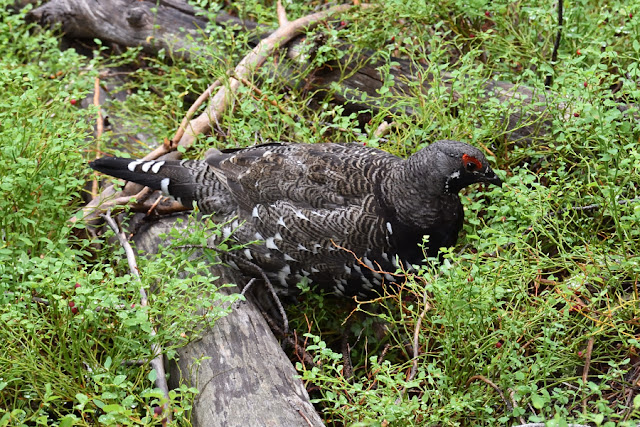As planned, we drove back up to the Park Creek Overlook to search for Three-toed and possibly Black-backed Woodpecker. Once again, we saw Sandhill Crane, the Great Gray Owls, Common Nighthawk, Sage Thrasher, and Brewer's Sparrow, but the only woodpeckers present were Hairy, Pileated, and Northern Flicker. Belted Kingfisher, Clark's Nutcracker, Mountain Bluebird, White-crowned Sparrow, Cassin's Finch, and Pine Siskin were also noted there.
Since Stanley Lake was also mentioned as a woodpecker spot and was on the way back, we drove into there. A stop along the road to the lake produced Olive-sided Flycatcher, Red-breasted Nuthatch, Warbling Vireo, "Oregon" Junco, and Red Crossbill, but it was about to get much better. As Jason stepped over one of several fallen trees, two Three-toed Woodpeckers popped up onto one of them! It was a female and a young male. We watched the female feed the young one so close that I had to back up to keep them in the camera frame.
Female Three-toed Woodpecker (Yes, they have three toes.)
Young male Three-toed Woodpecker
As if that wasn't good enough, a Williamson's Sapsucker flew over us and landed on a nearby trunk just long enough for me to get this mediocre photo.
Young male Williamson's Sapsucker
We continued on to the lake and walked along the west end of it. There, we found Great Blue Heron, Ring-necked Duck, Common Merganser, Belted Kingfisher, Olive-sided Flycatcher, Violet-green Swallow, and Yellow Warbler.
We headed back through Stanley, followed Route 75 all the way down the Salmon River to Chalis, and headed south on Route 93. Just south of Chalis, a small reservoir held Northern Shoveler, Gadwall, American Wigeon, Canvasback, Redhead, Ring-necked Duck, Hooded Merganser, Ruddy Duck, American Coot, Black-necked Stilt, Lesser Yellowlegs, Spotted and Solitary Sandpiper, and Black-billed Magpie. Farther south, a Trumpeter Swan was in a little wetlands near Chilly. We stopped in the town of Arco and got something to eat at Pickle's Place.
From there, we headed east on Route 20 to Idaho Falls and north on I-15 to the Camas National Wildlife Refuge, arriving in the late afternoon.
Camas National Wildlife Refuge
Birds seen at the feeder area by the headquarters included Eurasian Collared-Dove, Rufous Hummingbird, Western Kingbird, Black-headed Grosbeak, and Lazuli Bunting. A large list of birds seen along the Auto Tour Route included White-faced Ibis, Trumpeter Swan, Green-winged, Blue-winged, and Cinnamon Teal, Northern Pintail, Northern Shoveler, Gadwall, American Wigeon, Ring-necked Duck, Hooded Merganser, Ruddy Duck, Northern Harrier, Red-tailed and Swainson's Hawk, American Kestrel, Virginia Rail, Sora, American Coot, Sandhill Crane, Killdeer, Lesser Yellowlegs, Spotted, Solitary, and Least Sandpiper, Willet, Wilson's Snipe, Wilson's Phalarope, California and Franklin's Gull, Common Nighthawk, Eastern Kingbird, Cliff and Barn Swallow, Marsh Wren, Savannah and Vesper Sparrow, Red-winged, Yellow-headed, and Brewer's Blackbird, Western Meadowlark, and American Goldfinch.
Eared Grebe
We left the refuge and drove the remaining distance to Rexburg. Swainson's Hawks were pretty numerous along Route 33.
Swainson's Hawk
At the motel, we set our alarms for 3:30 AM in order to get into Yellowstone by first light.


















































